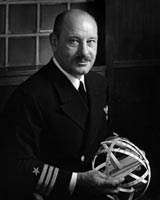Luis de Florez
Luis de Florez (March 4, 1889[1] − November, 1962) was a naval aviator and a Rear Admiral in the United States Navy that was actively involved in experimental aerospace development projects for the United States Government. As both an active duty and a retired U.S. Navy admiral, de Florez was influential in the development of early flight simulators, and was a pioneer in the use of "virtual reality" to simulate flight and combat situations in World War II.[2]
Luis de Florez | |
|---|---|
 Commander Luis de Florez | |
| Born | March 4, 1889 New York City |
| Died | November 1962 (aged 73) Connecticut |
| Allegiance | |
| Service/ | |
| Rank | |
| Battles/wars | World War I World War II |
| Awards | Legion of Merit |
Biography

Luis de Florez was from New York City. De Florez attended MIT, and graduated in 1911 with a B.S. in Mechanical Engineering.[3] He wrote his thesis on the subject of an aircraft problem, titled "Thrust of Propellers in Flight." The Admiral de Florez Design and Innovation Award is named after him, and his son, Peter de Florez, who was an MIT professor, established a $500,000 fund to foster and encourage activities related to humor at MIT.[4] The de Florez Prize in Human Engineering was established in 1964 at his bequest.
De Florez worked in the United States Navy as a career officer in World War I. He worked in the aviation section of the Navy and also on the development of refinery technology.
In the 1930s, De Florez also worked as an engineering consultant for various oil companies. His name is on several patents, including a 1918 U.S. patent (#1,264,374) for a "Liquid prism device"[5] with rigid closed sides which included a system for varying the density of a medium filling the prism and thereby varying the refraction of light waves passing through the prism, and a 1930 Canadian patent for the "cracking and distillation of hydrocarbon oils".[6] During World War II, he gave up his business to help solve the Navy's training problems.
World War II
In 1941, then Commander de Florez visited the United Kingdom and wrote what would become an influential report on British aircraft simulator techniques. It influenced the establishing of the Special Devices Division of the Navy's Bureau of Aeronautics (what would later become the NAWCTSD).[7] Later that year, Commander de Florez became head of the new Special Devices Desk in the Engineering Division of the Navy's Bureau of Aeronautics. De Florez championed the use of "synthetic training devices" and urged the Navy to undertake development of such devices to increase readiness. He also worked on the development of antisubmarine devices. De Florez has been credited with over sixty inventions.
During World War II, he was subsequently promoted to captain and then to Flag rank, becoming a rear admiral in 1944.
In 1944, de Florez was awarded the Robert J. Collier Trophy for 1943 for his work in training combat pilots and flight crews through the development of inexpensive synthetic devices.[8]
De Florez was awarded with the Legion of Merit in June 1945.[9]
Post-war
In 1946, Tufts University awarded de Florez an honorary Doctor of Science degree at commencement.
Admiral de Florez was the first director of technical research at the CIA. In 1950, de Florez helped Robert Fulton get a contract with the Office of Naval Research to develop the Fulton surface-to-air recovery system. In 1954, as the CIA's chairman of research, de Florez argued against reprimanding those responsible for the then-secret but now controversial MKULTRA L.S.D. research program.[10]
In the mid-1950s, de Florez was the president of the Flight Safety Foundation. Presented since 1966, the Foundation's Admiral Luis de Florez Flight Safety Award is named after him.[11] It recognizes "outstanding individual contributions to aviation safety, through basic design, device or practice." De Florez established a trust to support the award that provides each recipient with $1,000.
De Florez worked as an aide to Navy Vice Admiral Harold G. Bowen, Sr., Director of Office of Research and Invention (ORI) (later named ONR).[12] He also once served as a director of Douglas Aircraft Corp.
Luis de Florez died in November 1962,[13] at the age of 73[3] in the cockpit of his airplane, which was ready for take-off at a Connecticut airport. The main building complex at the Naval Air Warfare Center Training Systems Division, Naval Support Activity Orlando, Florida, is named in his honor.
References
| Wikimedia Commons has media related to Luis de Florez. |
- Chrysler Corporation LLC: This Day in Auto History:
- Viktor Schrekengost: sculptor, patriot.(Open Sources) Industry & Business Article - Research, News, Information, Contacts, Divisions, Subsidiaries, Business Associations
- Concise Encyclopedia of Tufts History (ed. Anne Sauer)
- Keyser named de Florez Professor
- Liquid prism device - Patent 4953956
- CIPO - Patent - 305942 Archived 2012-07-29 at Archive.today
- A Brief History of Aircraft Flight Simulation ( Flight Training ) Archived 2011-05-26 at the Wayback Machine
- museum
- It's Fun - TIME
- C.I.A.'s Files on LSD Death Found to be Contradictory
- Flight Safety Foundation Admiral Luis de Florez Flight Safety Award Archived 2008-05-15 at the Wayback Machine
- Doc Ewen: The Horn, HI, and Other Events in US Radio Astronomy
- Luis deFlorez
- Hispanics in the US Navy Archived 2011-05-12 at the Wayback Machine